Rear seat FORD KUGA 2010 1.G Owners Manual
[x] Cancel search | Manufacturer: FORD, Model Year: 2010, Model line: KUGA, Model: FORD KUGA 2010 1.GPages: 226, PDF Size: 8.07 MB
Page 3 of 226
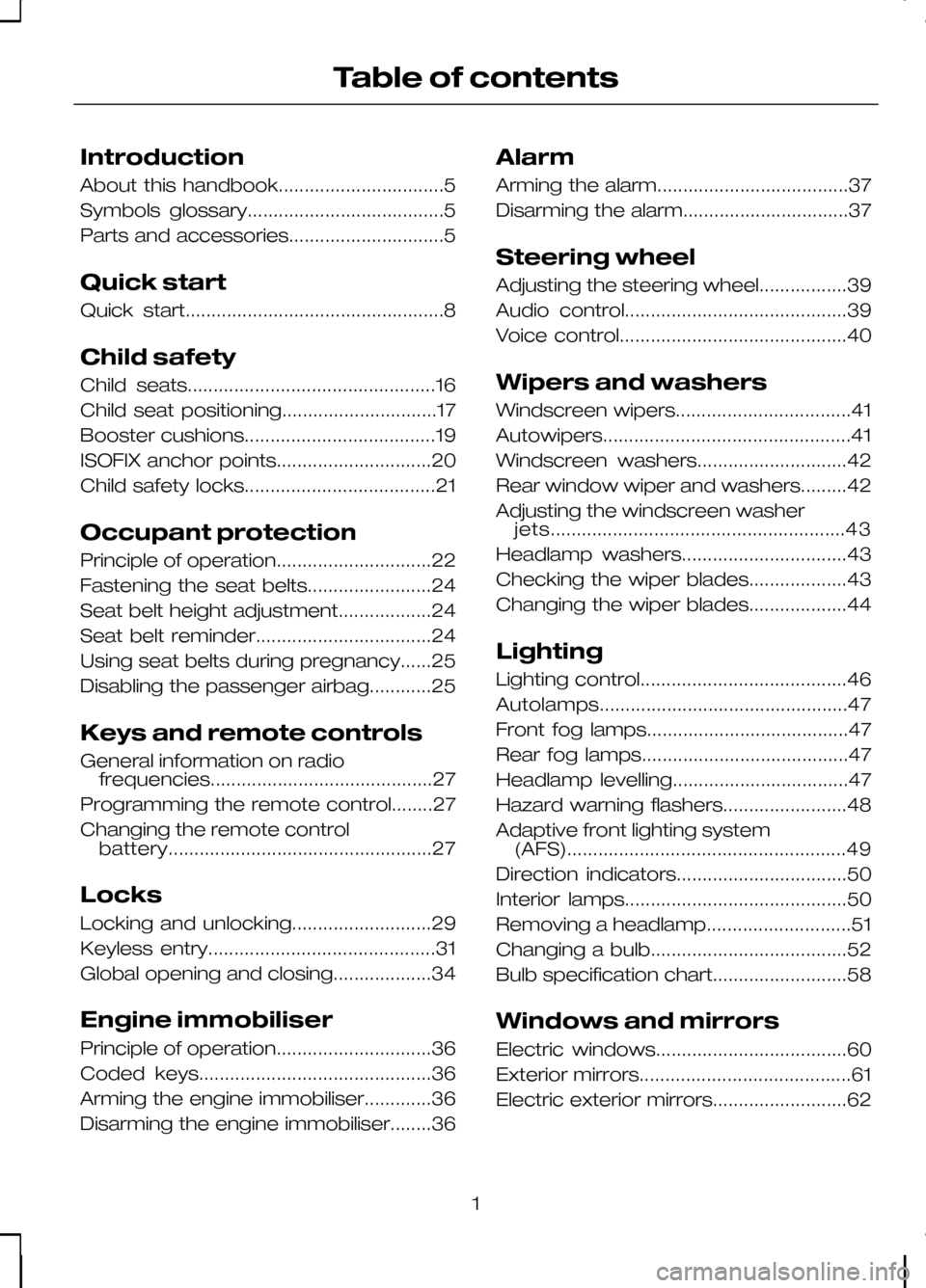
Introduction
About this handbook................................5
Symbols glossary......................................5
Parts and accessories..............................5
Quick start
Quick start..................................................8
Child safety
Child seats................................................16
Child seat positioning..............................17
Booster cushions.....................................19
ISOFIX anchor points..............................20
Child safety locks.....................................21
Occupant protection
Principle of operation..............................22
Fastening the seat belts........................24
Seat belt height adjustment..................24
Seat belt reminder..................................24
Using seat belts during pregnancy......25
Disabling the passenger airbag............25
Keys and remote controls
General information on radio
frequencies...........................................27
Programming the remote control........27
Changing the remote control battery...................................................27
Locks
Locking and unlocking...........................29
Keyless entry............................................31
Global opening and closing...................34
Engine immobiliser
Principle of operation..............................36
Coded keys.............................................36
Arming the engine immobiliser.............36
Disarming the engine immobiliser........36 Alarm
Arming the alarm.....................................37
Disarming the alarm................................37
Steering wheel
Adjusting the steering wheel.................39
Audio control...........................................39
Voice control............................................40
Wipers and washers
Windscreen wipers..................................41
Autowipers................................................41
Windscreen washers.............................42
Rear window wiper and washers.........42
Adjusting the windscreen washer
jets.........................................................43
Headlamp washers................................43
Checking the wiper blades...................43
Changing the wiper blades...................44
Lighting
Lighting control........................................46
Autolamps................................................47
Front fog lamps.......................................47
Rear fog lamps........................................47
Headlamp levelling..................................47
Hazard warning flashers........................48
Adaptive front lighting system (AFS)......................................................49
Direction indicators.................................50
Interior lamps...........................................50
Removing a headlamp............................51
Changing a bulb......................................52
Bulb specification chart..........................58
Windows and mirrors
Electric windows.....................................60
Exterior mirrors.........................................61
Electric exterior mirrors..........................62
1
Table of contents
Page 4 of 226
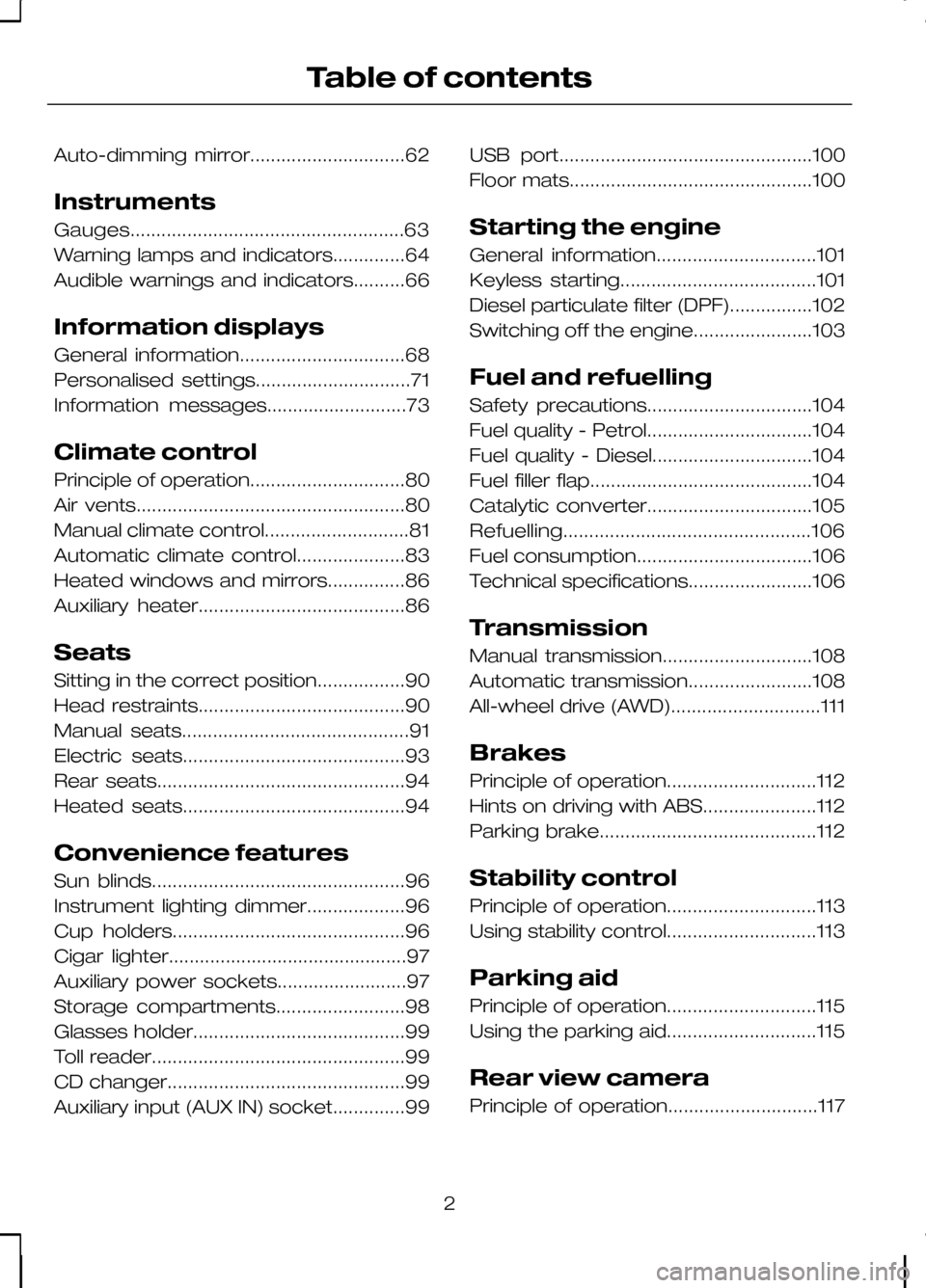
Auto-dimming mirror..............................62
Instruments
Gauges.....................................................63
Warning lamps and indicators..............64
Audible warnings and indicators..........66
Information displays
General information................................68
Personalised settings..............................71
Information messages...........................73
Climate control
Principle of operation..............................80
Air vents....................................................80
Manual climate control............................81
Automatic climate control.....................83
Heated windows and mirrors...............86
Auxiliary heater........................................86
Seats
Sitting in the correct position.................90
Head restraints........................................90
Manual seats............................................91
Electric seats...........................................93
Rear seats................................................94
Heated seats...........................................94
Convenience features
Sun blinds.................................................96
Instrument lighting dimmer...................96
Cup holders.............................................96
Cigar lighter..............................................97
Auxiliary power sockets.........................97
Storage compartments.........................98
Glasses holder.........................................99
Toll reader.................................................99
CD changer..............................................99
Auxiliary input (AUX IN) socket..............99
USB port.................................................100
Floor mats...............................................100
Starting the engine
General information...............................101
Keyless starting......................................101
Diesel particulate filter (DPF)................102
Switching off the engine.......................103
Fuel and refuelling
Safety precautions................................104
Fuel quality - Petrol................................104
Fuel quality - Diesel...............................104
Fuel filler flap...........................................104
Catalytic converter................................105
Refuelling................................................106
Fuel consumption..................................106
Technical specifications........................106
Transmission
Manual transmission.............................108
Automatic transmission........................108
All-wheel drive (AWD).............................111
Brakes
Principle of operation.............................112
Hints on driving with ABS......................112
Parking brake..........................................112
Stability control
Principle of operation.............................113
Using stability control.............................113
Parking aid
Principle of operation.............................115
Using the parking aid.............................115
Rear view camera
Principle of operation.............................117
2
Table of contents
Page 12 of 226

Horn.
E
Wiper lever. See Wipers and washers (page 41).
F
Card holder.
G
Air vents. See Air vents(page 80).
H
Hazard warning flasher switch. See Hazard warning flashers(page 48).
I
Airbag deactivation indicator. See Disabling the passenger airbag (page
25). Parking aid switch. See Using the parking aid(page 115).
J
Start button. See Keyless starting (page 101).
J
Heated windscreen switch. See Heated windows and mirrors (page
86).
K
Heated rear window switch. See Heated windows and mirrors (page
86).
L
Climate controls. See Climate control(page 80).
M
Audio or navigation unit. See separate handbook.
N
Heated front seat switch. See Heated seats(page 94).
O
Ignition switch.
P
Steering wheel adjustment. See Adjusting the steering wheel (page 39).
Q
Cruise control switches. See Using cruise control(page 120).
R
Audio controls. See Audio control(page 39).
S
Instrument lighting dimmer. See Instrument lighting dimmer(page 96).
T
10Quick start
Page 18 of 226
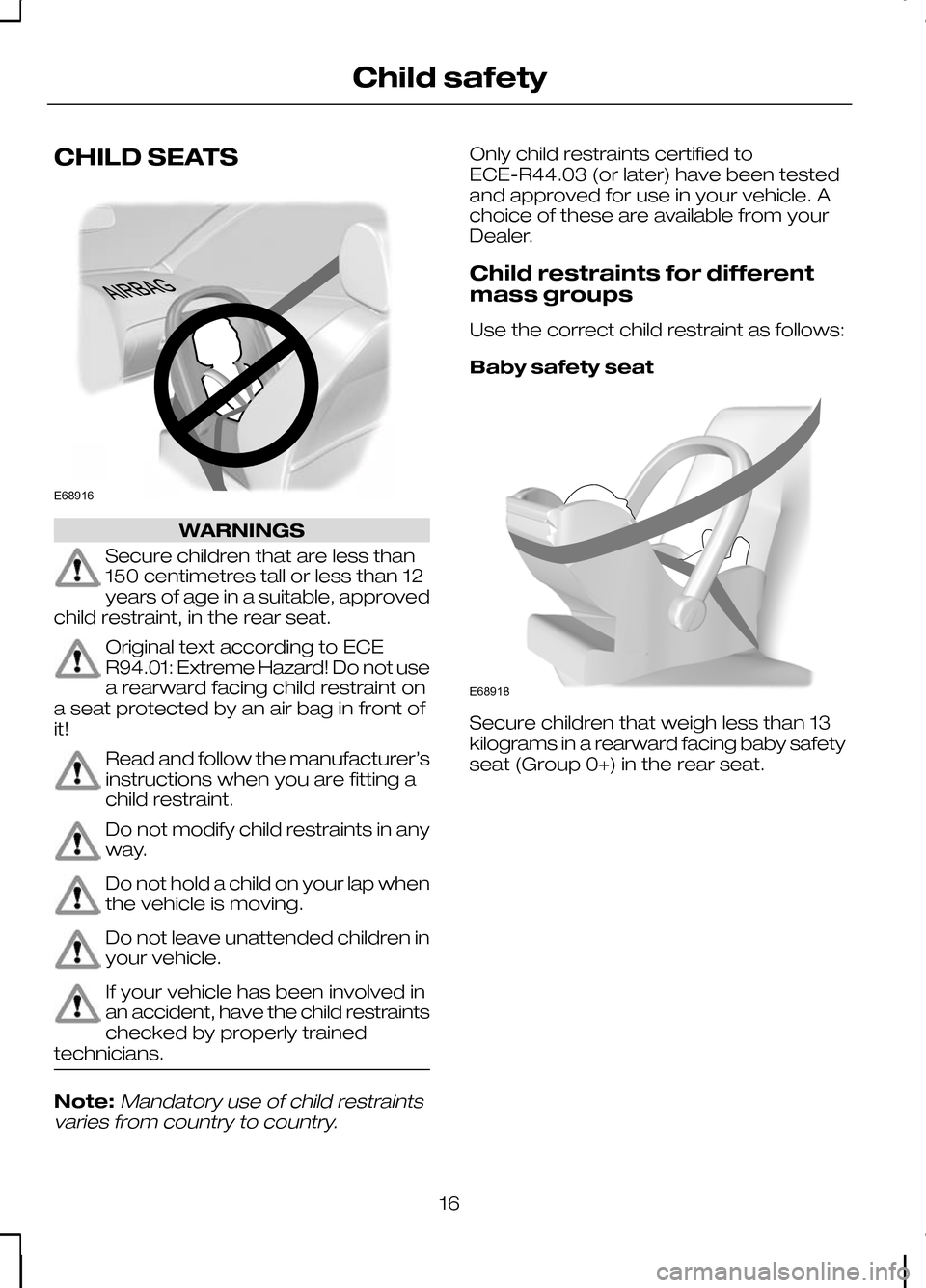
CHILD SEATS
WARNINGS
Secure children that are less than
150 centimetres tall or less than 12
years of age in a suitable, approved
child restraint, in the rear seat. Original text according to ECE
R94.01: Extreme Hazard! Do not use
a rearward facing child restraint on
a seat protected by an air bag in front of
it! Read and follow the manufacturer’s
instructions when you are fitting a
child restraint.
Do not modify child restraints in any
way.
Do not hold a child on your lap when
the vehicle is moving.
Do not leave unattended children in
your vehicle.
If your vehicle has been involved in
an accident, have the child restraints
checked by properly trained
technicians. Note:Mandatory use of child restraints
varies from country to country.
Only child restraints certified to
ECE-R44.03 (or later) have been tested
and approved for use in your vehicle. A
choice of these are available from your
Dealer.
Child restraints for different
mass groups
Use the correct child restraint as follows:
Baby safety seat Secure children that weigh less than 13
kilograms in a rearward facing baby safety
seat (Group 0+) in the rear seat.
16
Child safetyE68916 E68918
Page 19 of 226
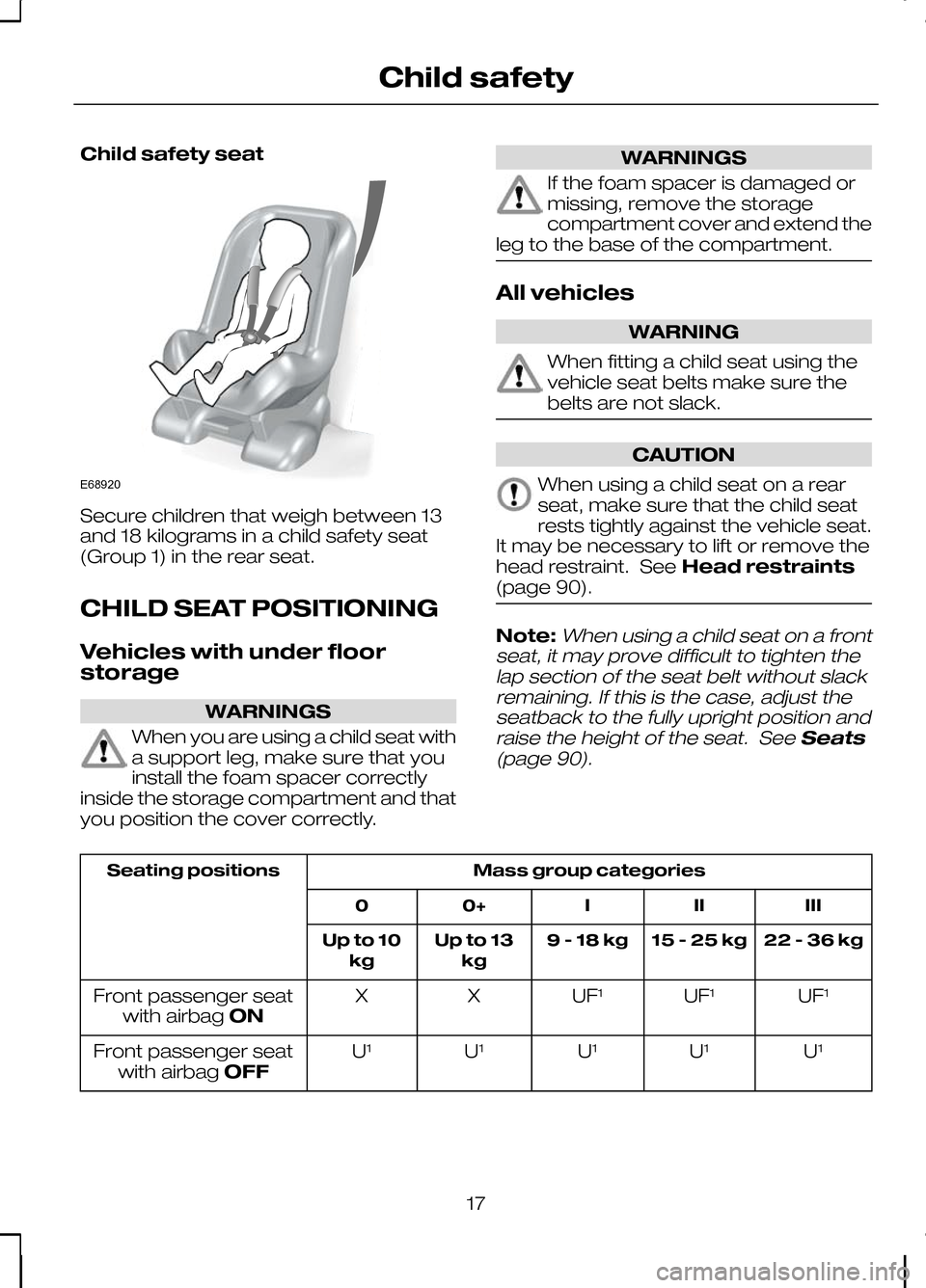
Child safety seat
Secure children that weigh between 13
and 18 kilograms in a child safety seat
(Group 1) in the rear seat.
CHILD SEAT POSITIONING
Vehicles with under floor
storage
WARNINGS
When you are using a child seat with
a support leg, make sure that you
install the foam spacer correctly
inside the storage compartment and that
you position the cover correctly. WARNINGS
If the foam spacer is damaged or
missing, remove the storage
compartment cover and extend the
leg to the base of the compartment. All vehicles
WARNING
When fitting a child seat using the
vehicle seat belts make sure the
belts are not slack.
CAUTION
When using a child seat on a rear
seat, make sure that the child seat
rests tightly against the vehicle seat.
It may be necessary to lift or remove the
head restraint. See Head restraints
(page 90). Note:When using a child seat on a front
seat, it may prove difficult to tighten the lap section of the seat belt without slackremaining. If this is the case, adjust theseatback to the fully upright position and
raise the height of the seat. See Seats
(page 90). Mass group categories
Seating positions
III
II
I
0+
0
22 - 36 kg
15 - 25 kg
9 - 18 kg
Up to 13
kg
Up to 10
kg
UF¹
UF¹
UF¹
X
X
Front passenger seat
with airbag ON
U¹
U¹
U¹
U¹
U¹
Front passenger seat
with airbag OFF
17
Child safetyE68920
Page 20 of 226
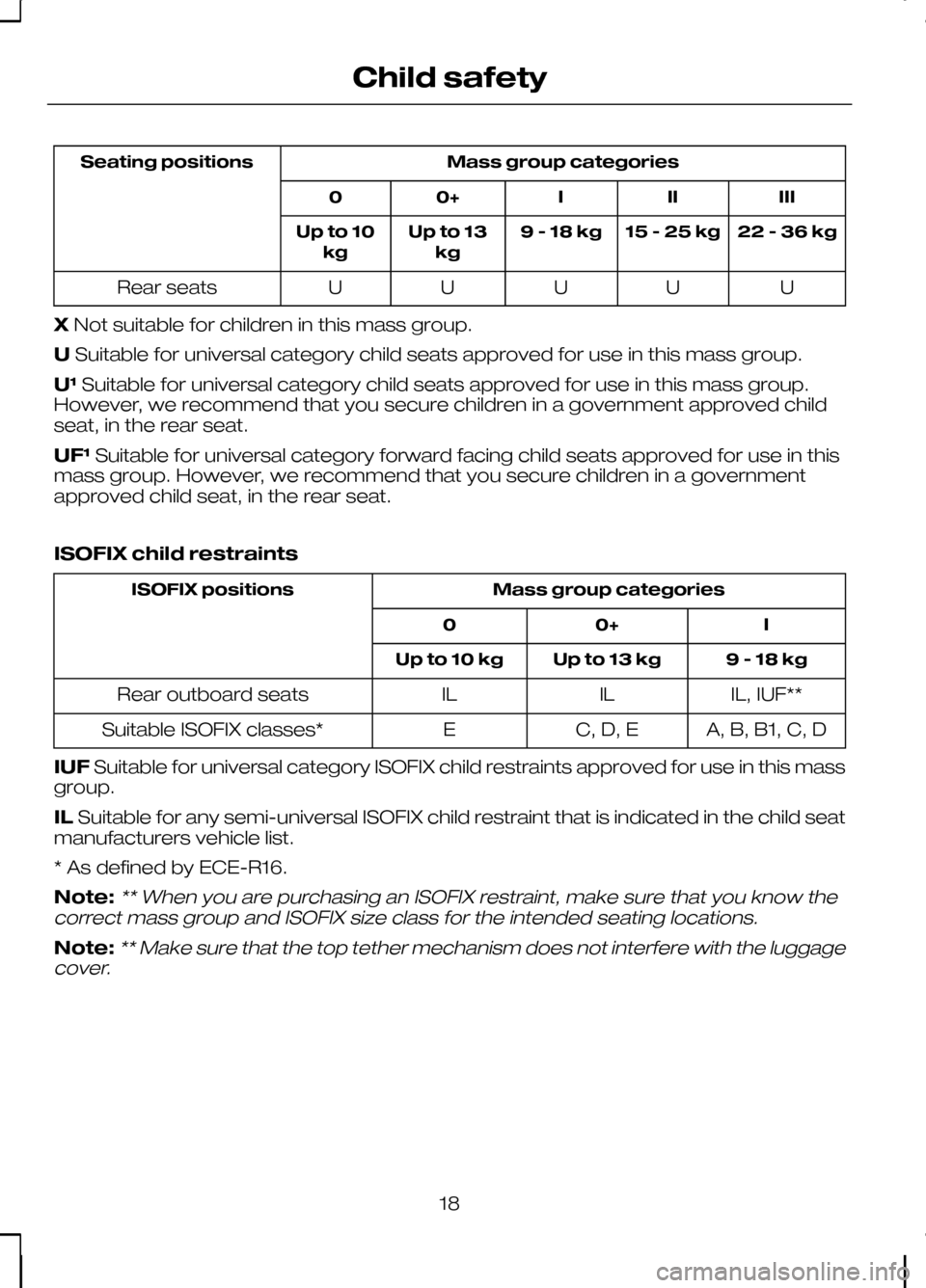
Mass group categories
Seating positions
III
II
I
0+
0
22 - 36 kg
15 - 25 kg
9 - 18 kg
Up to 13
kg
Up to 10
kg
U
U
U
U
U
Rear seats
X Not suitable for children in this mass group.
U Suitable for universal category child seats approved for use in this mass group.
U¹ Suitable for universal category child seats approved for use in this mass group.
However, we recommend that you secure children in a government approved child
seat, in the rear seat.
UF¹ Suitable for universal category forward facing child seats approved for use in this
mass group. However, we recommend that you secure children in a government
approved child seat, in the rear seat.
ISOFIX child restraints Mass group categories
ISOFIX positions
I
0+
0
9 - 18 kg
Up to 13 kg
Up to 10 kg
IL, IUF**
IL
IL
Rear outboard seats
A, B, B1, C, D
C, D, E
E
Suitable ISOFIX classes*
IUF Suitable for universal category ISOFIX child restraints approved for use in this mass
group.
IL Suitable for any semi-universal ISOFIX child restraint that is indicated in the child seat
manufacturers vehicle list.
* As defined by ECE-R16.
Note:** When you are purchasing an ISOFIX restraint, make sure that you know the
correct mass group and ISOFIX size class for the intended seating locations.
Note:** Make sure that the top tether mechanism does not interfere with the luggage
cover.
18
Child safety
Page 21 of 226
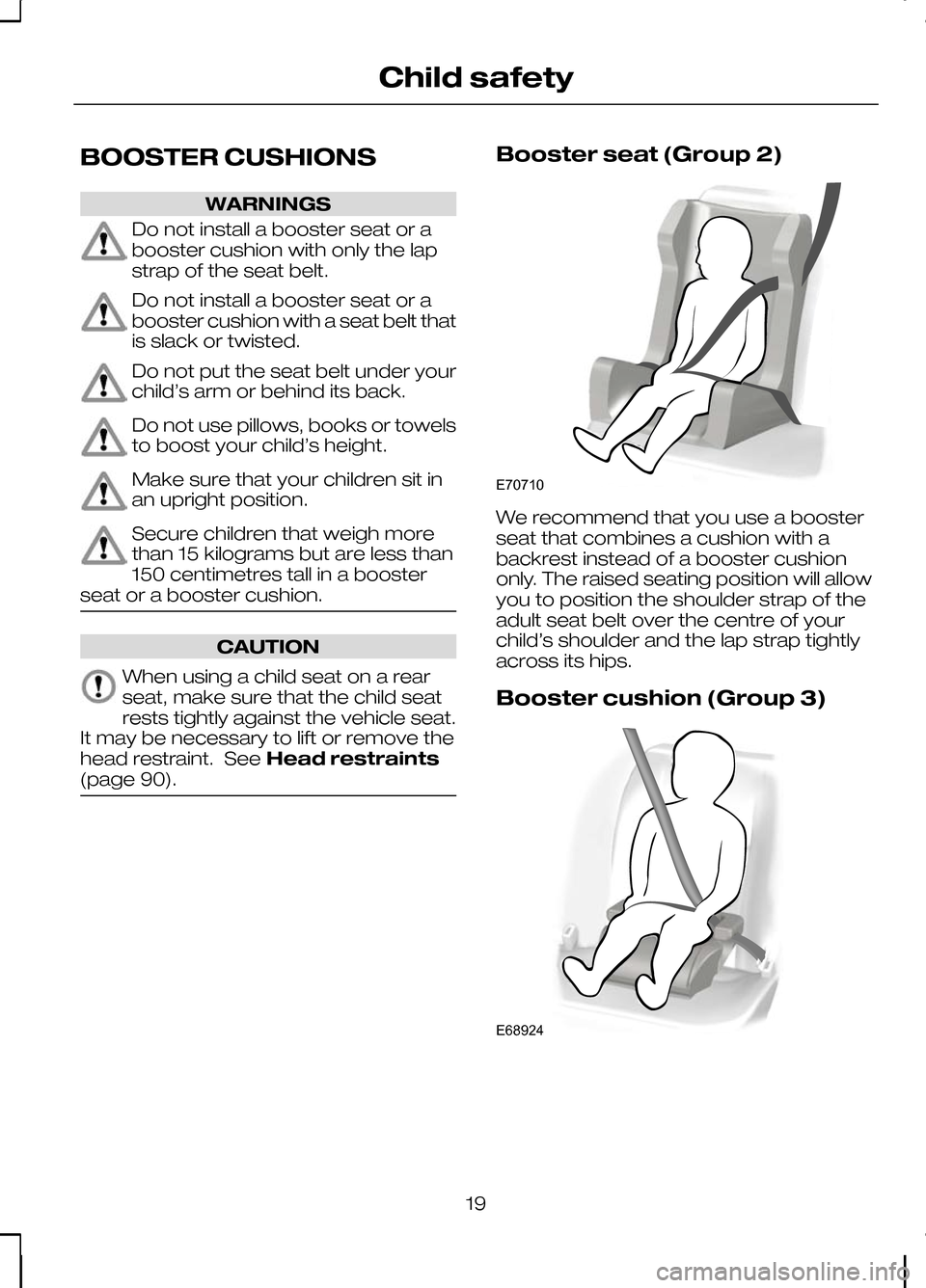
BOOSTER CUSHIONS
WARNINGS
Do not install a booster seat or a
booster cushion with only the lap
strap of the seat belt.
Do not install a booster seat or a
booster cushion with a seat belt that
is slack or twisted.
Do not put the seat belt under your
child’s arm or behind its back.
Do not use pillows, books or towels
to boost your child’s height.
Make sure that your children sit in
an upright position.
Secure children that weigh more
than 15 kilograms but are less than
150 centimetres tall in a booster
seat or a booster cushion. CAUTION
When using a child seat on a rear
seat, make sure that the child seat
rests tightly against the vehicle seat.
It may be necessary to lift or remove the
head restraint. See Head restraints
(page 90). Booster seat (Group 2)
We recommend that you use a booster
seat that combines a cushion with a
backrest instead of a booster cushion
only. The raised seating position will allow
you to position the shoulder strap of the
adult seat belt over the centre of your
child’s shoulder and the lap strap tightly
across its hips.
Booster cushion (Group 3)
19
Child safetyE70710 E68924
Page 22 of 226

ISOFIX ANCHOR POINTS
You can fit ISOFIX child restraints using
the ISOFIX anchor points.
Your vehicle is fitted with ISOFIX anchor
points that accommodate universally
approved ISOFIX child restraints.
The ISOFIX system comprises of two rigid
attachment arms on the child restraint
that attach to anchor points on the rear
seats, where the cushion and backrest
meet.
A third anchor point has been provided
for child seats that are equipped with a
top tether, available for use in the forward
facing configuration.
The top tether anchors in your vehicle are
located on the floor of the luggage
compartment.
The tether strap should be routed
beneath the raised rear head restraint, to
the anchor point on the floor of the
luggage compartment. The anchor point
is identified by a pictogram.
After installing the child safety seat, tighten
the tether strap according to the
manufacturer's instructions. WARNING
Use an anti-rotation device when
using the ISOFIX system. We
recommend that you use a top
tether or a support leg. Attaching a child restraint with
a top tether
WARNING
Do not attach a tether strap to
anything other than the correct
tether anchor point.
Route the tether strap to the anchor point.
Tighten the tether strap to the
manufacturer's instructions.
WARNINGS
Make sure the top tether strap is not
slack or twisted and is properly
located on the anchor point.
Make sure that the seatback is
secure and fully engaged in the
catch.
20
Child safetyE68945 E78828
Page 24 of 226
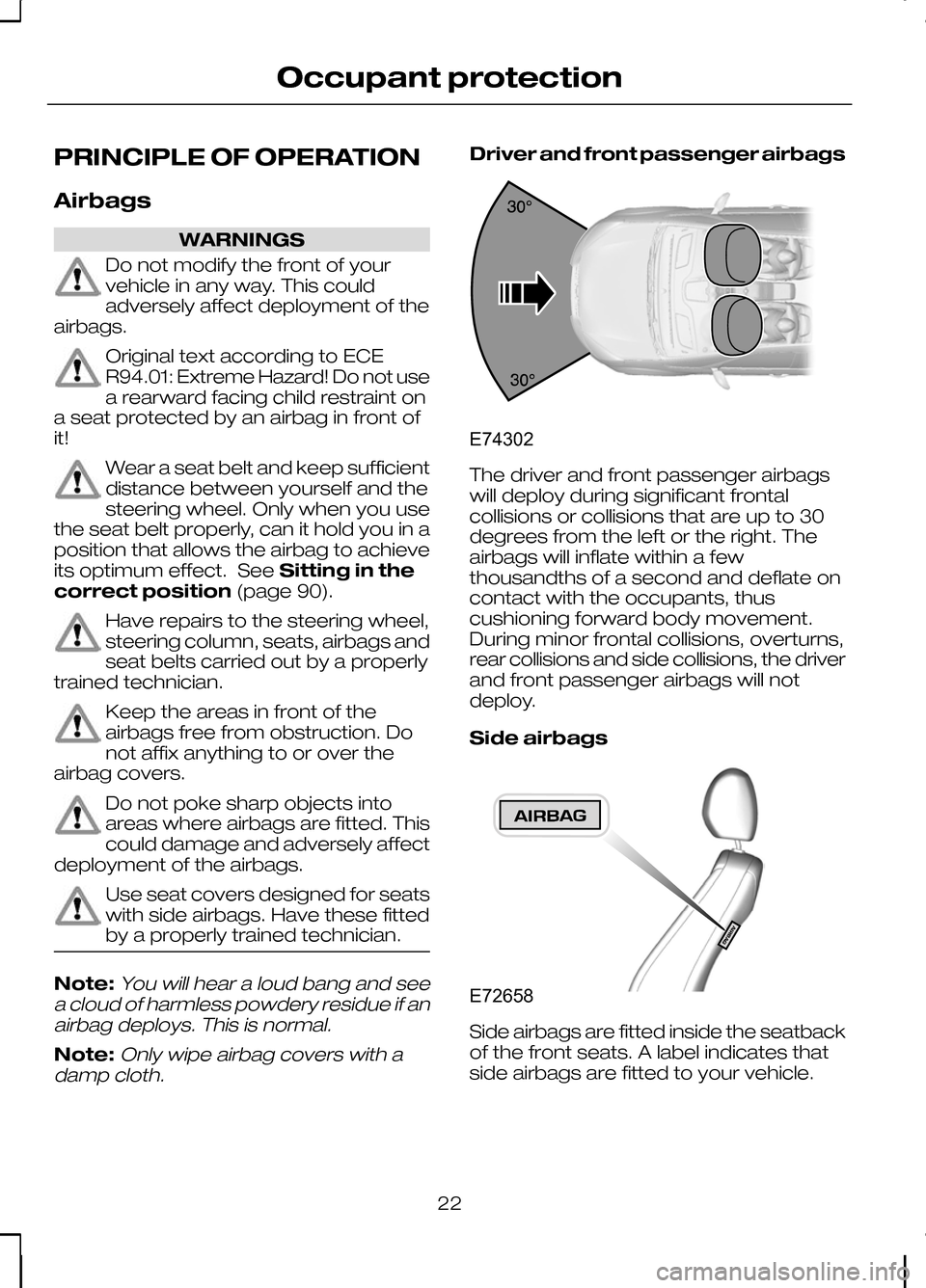
PRINCIPLE OF OPERATION
Airbags
WARNINGS
Do not modify the front of your
vehicle in any way. This could
adversely affect deployment of the
airbags. Original text according to ECE
R94.01: Extreme Hazard! Do not use
a rearward facing child restraint on
a seat protected by an airbag in front of
it! Wear a seat belt and keep sufficient
distance between yourself and the
steering wheel. Only when you use
the seat belt properly, can it hold you in a
position that allows the airbag to achieve
its optimum effect. See Sitting in the
correct position (page 90).Have repairs to the steering wheel,
steering column, seats, airbags and
seat belts carried out by a properly
trained technician. Keep the areas in front of the
airbags free from obstruction. Do
not affix anything to or over the
airbag covers. Do not poke sharp objects into
areas where airbags are fitted. This
could damage and adversely affect
deployment of the airbags. Use seat covers designed for seats
with side airbags. Have these fitted
by a properly trained technician.
Note:You will hear a loud bang and see
a cloud of harmless powdery residue if an airbag deploys. This is normal.
Note:Only wipe airbag covers with a
damp cloth.
Driver and front passenger airbags The driver and front passenger airbags
will deploy during significant frontal
collisions or collisions that are up to 30
degrees from the left or the right. The
airbags will inflate within a few
thousandths of a second and deflate on
contact with the occupants, thus
cushioning forward body movement.
During minor frontal collisions, overturns,
rear collisions and side collisions, the driver
and front passenger airbags will not
deploy.
Side airbags
Side airbags are fitted inside the seatback
of the front seats. A label indicates that
side airbags are fitted to your vehicle.
22
Occupant protectionE74302 E72658
Page 25 of 226
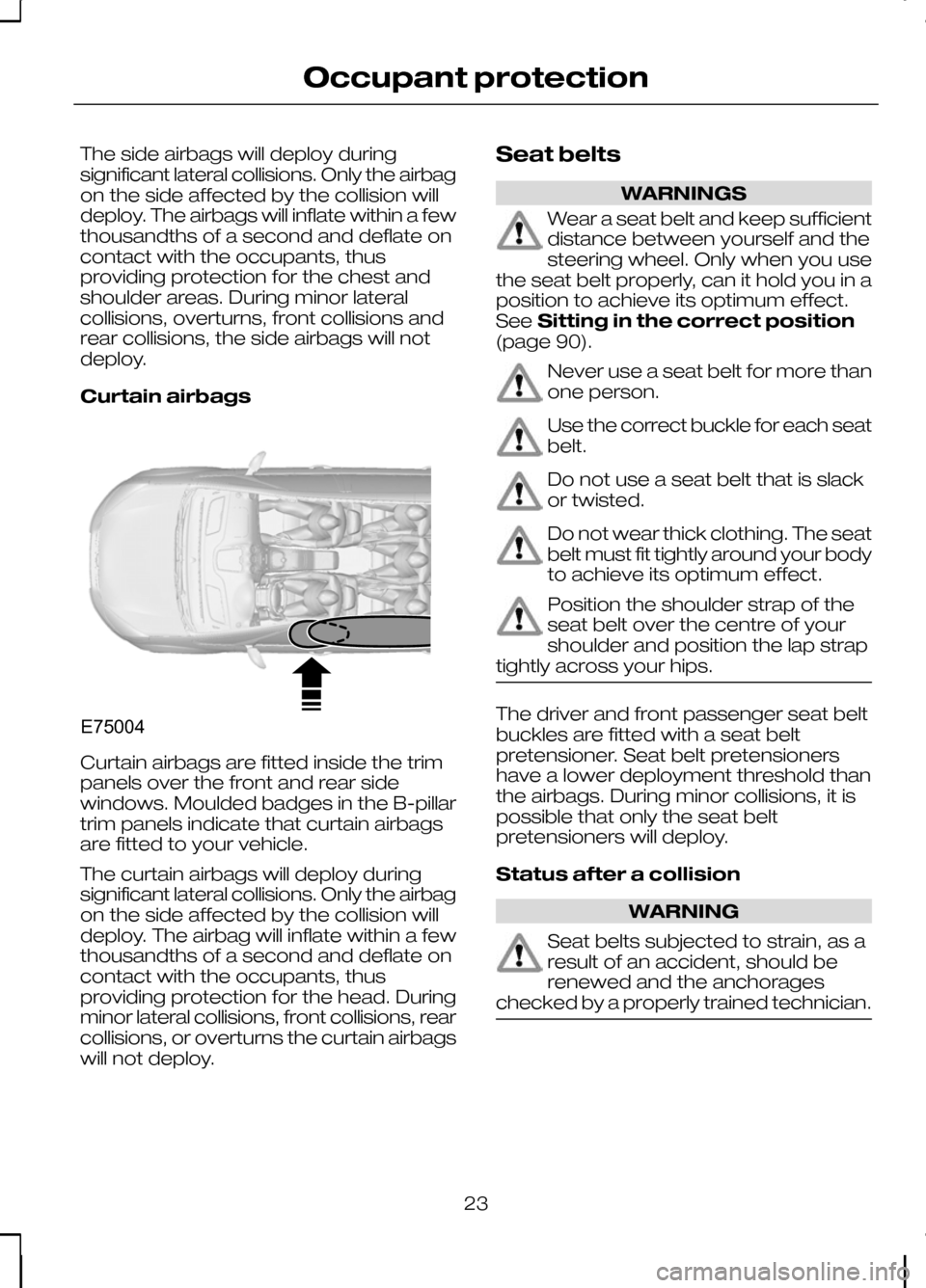
The side airbags will deploy during
significant lateral collisions. Only the airbag
on the side affected by the collision will
deploy. The airbags will inflate within a few
thousandths of a second and deflate on
contact with the occupants, thus
providing protection for the chest and
shoulder areas. During minor lateral
collisions, overturns, front collisions and
rear collisions, the side airbags will not
deploy.
Curtain airbags
Curtain airbags are fitted inside the trim
panels over the front and rear side
windows. Moulded badges in the B-pillar
trim panels indicate that curtain airbags
are fitted to your vehicle.
The curtain airbags will deploy during
significant lateral collisions. Only the airbag
on the side affected by the collision will
deploy. The airbag will inflate within a few
thousandths of a second and deflate on
contact with the occupants, thus
providing protection for the head. During
minor lateral collisions, front collisions, rear
collisions, or overturns the curtain airbags
will not deploy. Seat belts WARNINGS
Wear a seat belt and keep sufficient
distance between yourself and the
steering wheel. Only when you use
the seat belt properly, can it hold you in a
position to achieve its optimum effect.
See Sitting in the correct position
(page 90). Never use a seat belt for more than
one person.
Use the correct buckle for each seat
belt.
Do not use a seat belt that is slack
or twisted.
Do not wear thick clothing. The seat
belt must fit tightly around your body
to achieve its optimum effect.
Position the shoulder strap of the
seat belt over the centre of your
shoulder and position the lap strap
tightly across your hips. The driver and front passenger seat belt
buckles are fitted with a seat belt
pretensioner. Seat belt pretensioners
have a lower deployment threshold than
the airbags. During minor collisions, it is
possible that only the seat belt
pretensioners will deploy.
Status after a collision
WARNING
Seat belts subjected to strain, as a
result of an accident, should be
renewed and the anchorages
checked by a properly trained technician. 23
Occupant protectionE75004